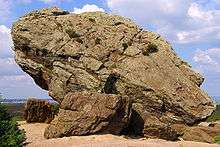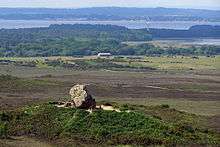Agglestone Rock


Agglestone Rock, also known as the Devil's Anvil,[1] is a sandstone block of about 400 tonnes weight, perched on a conical hill, approximately 1 mile from the village of Studland, south Dorset.[2] Legend has it that the devil threw the rock from The Needles on the Isle of Wight with the intention of hitting either Corfe Castle, Bindon Abbey or Salisbury Cathedral.[1][2] "Aggle" was taken into the old Dorset dialect as meaning "to wobble".[1]
Geology
The rock is an "eroded relic of iron-cemented, Tertiary sandstone, the Agglestone Grit".[2] It used to be anvil-shaped, but has since changed form due to erosion and been toppled.
Visiting the rock was listed by the Dorset Echo as one of the "25 Things To Do In Dorset Before You Die".[3]
Mythology
" A musing stroll across the heath from Studland, brings you to the Aggllestone, the holy stone (Helig - Anglo-Saxon for holy) hurled by the devil on to the crest of a hillock rising above the peaty waste. Fiends often do dress like angels, and it is certainly hard to detect anything of the devil when the Madonna-blue chalices of that visionary flower, Gentiana pneumonanthe, are open on the heath. But devils did traffic with holy stones in archaic England, for devils were once gods themselves fallen from heaven upon evil days, the days when the usurping Celts looked with dread upon the works of their predecessors. For the Agglestone is a menhir".
Taken from Downland Man by H.J. Massingham Pub 1927 by Jonathan Cape
As listed on The Modern Antiquarian website[4]
References
- 1 2 3 Maureen Hymas (1981). Dorset Folklore. Books of Wessex Ltd. p. 33. ISBN 0 90157550 X.
- 1 2 3 Ian West (2007-03-06). "Studland - Tertiary Cliffs and the Agglestone". Ian West, Southampton University.
- ↑ Dorset Echo - News, Sport, Homes, Jobs, Cars and Local Information in Weymouth, Portland, Dorchester Archived September 26, 2007, at the Wayback Machine.
- ↑ The Modern Antiquarian.com | UK | The Agglestone (Natural Rock Feature)
Coordinates: 50°38′42″N 1°58′05″W / 50.645083°N 1.968125°W